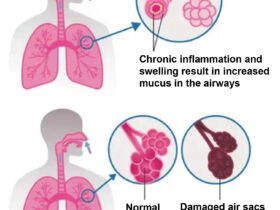By Virginia “Ginya” Carnahan, APR.CPRC, Director of Marketing & Development, Dattoli Cancer Center & Brachytherapy Research Institute
 Yes, if it is September it is Prostate Cancer Awareness Month. For fun, we created a little quiz this month. See how much you know about Prostate Cancer by taking this test and learning your score.
Yes, if it is September it is Prostate Cancer Awareness Month. For fun, we created a little quiz this month. See how much you know about Prostate Cancer by taking this test and learning your score.
1. What is the correct spelling of prostate?
a. Prostrate
b. Proztate
c. Prahstat
d. Prostate
2. Can both men and women have prostate cancer?
a. Yes!
b. No!
3. How big is a normal prostate?
a. The size of an orange
b. The size of a grape
c. The size of a walnut
d. The size of a football
4. The prostate gland is part of the lymphatic system.
a. True
b. False
5. Where is the prostate gland located?
a. Between the kidneys
b. Below the belly button
c. Attached to the appendix
d. Below the bladder
6. What is the number one cancer diagnosed in men today?
a. Colon
b. Prostate
c. Lung
d. Brain
7. What causes prostate cancer?
a. Heredity/genetics
b. Environment
c. Diet
d. Age
e. Any of the above
8. The blood test to assess prostate health is called
a. PSA
b. PAD
c. PSI
d. PDQ
9. Lycopenes (which are “good” carotenoids) are found in
a. Watermelon
b. Strawberries
c. Tomatoes
d. All of the above
10. Which of these are found in the prostate gland?
a. Peripheral zone
b. Transitional zone
c. Central zone
d. Demilitarized zone
11. The prostate gland contains two
a. Time zones
b. Hemispheres
c. Lobes
d. Seasons
12. The only way to definitively diagnose Prostate Cancer is with
a. An Xray
b. An MRI
c. An Ultrasound
d. A Biopsy
13. The symptoms of Prostate Cancer can be
a. Back Pain
b. Unexplained weight loss
c. Blood in urine or semen
d. Abnormal blood test
e. Difficulty urinating
f. Some or none of the above
14. The best treatment for Prostate Cancer is
a. DaVinci robotic surgery
b. Hormone treatment
c. Radioactive seed implants
d. Proton therapy
e. Photon radiation therapy
f. Cryotherapy (freezing)
g. HDR
h. HIFU
i. This is a trick question!
15. When should men start being screened for Prostate Cancer?
a. When they get married
b. When they get a driver’s license
c. Around age 50
d. When they apply for Medicare
16. Prostate Cancer can be contagious
a. No
b. Nyet
c. Never
d. No way
17. A diagnosis of Prostate Cancer means you will die
a. Not right away
b. Maybe later
c. Maybe a long time from now
d. Eventually (we all die)
e. When your insurance runs out
18. Chemotherapy is often used for treating Prostate Cancer (which is false?)
a. Not really
b. A type of chemotherapy using oral medications might be
c. Sometimes it is used in conjunction with other therapies
d. All men with prostate cancer will have to have chemotherapy
19. Some men can live a long time even with Prostate Cancer
a. True
b. False
20. Early diagnosis provides the best chance of
a. Getting to be on time
b. Being cured
c. Spending Christmas with grandchildren
d. Winning big in Las Vegas
ANSWER KEY:
1. D. The correct way to spell prostate is P R O S T A T E. It is often misspelled or mispronounced as prostrate, which is a word meaning “lying down, or prone.”
2. B. Only men can get prostate cancer (women, on the other hand can have ovarian and uterine cancer).
3. C. The normal prostate gland is about the size of a walnut.
4. B. The prostate gland is a part of the male reproductive system. Its function is to produce fluid to carry the semen.
5. D. The prostate is located at the base of the bladder.
6. B. The number one cancer diagnosis in men is prostate cancer. More than 230, 000 cases each year.
7. E. We don’t know exactly what causes prostate cancer. There is a strong genetic predisposition if a father or grandfather, brother or uncle had been found to have the disease.
8. A. PSA is prostatic specific antigen. It tracks an antigen level but alone it cannot diagnose the disease.
9. D. Lycopenes are found in red pigmented foods, and are good for maintaining a healthy prostate gland.
10. A.B. & C. These zones are used to describe areas within the gland.
11. C. The two lobes of the prostate are described as “right and left.”
12. D. The diagnosis of any cancer is made by examining a cell sample taken through a biopsy.
13. F. Often there are no symptoms of prostate cancer when the disease is just getting going early. By the time symptoms appear, the cancer has may have advanced and will be more difficult to treat.
14. I. This is a trick question. There are many good treatment options for prostate cancer that should be explored before making a decision.
15. C. National Cancer Institute has long recommended that men start screening for prostate cancer around age 50, unless there is a family history when screening should start earlier.
16. A. B. C. & D. Prostate cancer is not contagious!
17. Sorry – no one knows when you will die. Many men live many years after being successfully treated for prostate cancer. Each man’s cancer is different, however, and each man responds differently to treatment.
18. D. Chemotherapy is not a routine treatment for prostate cancer, but may be used for pain control in some cases of advanced, metastatic cancer.
19. A. See question # 17. There are many thousands of men alive today who have been successfully treated for their prostate cancer.
20. B. The key to cure is always early diagnosis. So don’t be afraid to get screened for prostate cancer. During this month you might even be able to find a place offering free screening in recognition of National Prostate Cancer Awareness Month.






